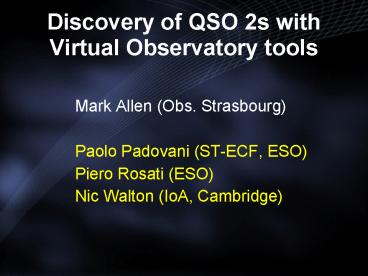Discovery of QSO 2s with Virtual Observatory tools - PowerPoint PPT Presentation
1 / 33
Title: Discovery of QSO 2s with Virtual Observatory tools
1
Discovery of QSO 2s with Virtual Observatory
tools
- Mark Allen (Obs. Strasbourg)
- Paolo Padovani (ST-ECF, ESO)
- Piero Rosati (ESO)
- Nic Walton (IoA, Cambridge)
2
(No Transcript)
3
AGN Unified Model
- Different types of AGN explained by
the physics of the - Black hole
- Accretion disk
- Jet and
- Torus
- Convolved with the geometry of the viewing angle
- Urry Padovani (1995), Jaffe et al. (2004)
4
Type 1
Type 2
5
Type 2 AGN
- Local low power type 2s Seyfert 2s
- High power counterparts QSO 2 (type 2
quasars), difficult to find. - Heavily reddened and fall through optical/UV
selection - However...
- Hard X-rays can penetrate the torus
6
- GOODS data
- (Great Observatories Origins Deep Survey)
- VO tools to find type 2 AGN.
- First Science for the AVO project
7
Virtual Observatories
- Status
- Prototype VO tools ? Scientific Results
- Real gains in the areas of
- Data access
- Manipulating image and catalogue data
- Remote calculations
- Enabled by VO infrastructure and Interoperability
standards
8
- RD on scientific requirements and technology for
building a VO - 6 European organisations
- 3 yr phase-A, 2001-2004/5
- Driven by strategy of scientific VO demonstrations
9
AVO prototype
- Registry of services (GLU)
- CDS Aladin interface
- Interactive manipulation of image and catalogue
data - Portal for access to services/data
- Cross-matching service for catalogues
- Conventions for accessing remote data
- Remote calculations
- Interoperable with other VO tools
10
Data
- GOODS Bviz Images Catalogues
- CDF-S (UDF), HDF-N 61647 sources
- Deep X-ray Chandra Catalogues
- Alexander et al. 2003
- HDF-N 2Ms (503)
- CDF-S 1Ms (326)
11
2MASS
ESO-WFI
Chandra
Data available at selected point are highlighted
in tree
VLT-ISAAC
HST-ACS
Field of view outlines are plotted automatically
DSS
Image metadata
My Data
12
Method
- Select candidates based on two key physical
properties of Type 2 AGN - Obscured absorbed
- Chandra X-ray catalogues
- High power to be classed as AGN
- Empirical relation for Lx using
flux(2-10 keV) / flux(R-band)
13
Absorbed sources
- HardnessRatio HR(H-S)/(HS) S 0.5 2.0
keV H 2-8 keV - Type 2 AGN have HR gt -0.2
- Increasing z makes sources appear softer
therefore discard some high-z type 2s - 294 absorbed sources (CDF-S 104, HDF-N190)
14
Optical counterparts
- X-match absorbed sources with GOODS z-band
catalogs - Detect and correct for systematic shift
- Take positional uncertainty into account
- (Match distance)/error lt 1
- Most match distances lt 1.25
- False match estimate 8 15
- Almost all (HDF-N, CDF-S) X-ray sources have
optical counterparts
15
Estimate X-ray Power
- Fiore et al. (2003) relation for type 2
objects - flux(2-10 keV) / flux(R)
L(nucleus) / L(host galaxy R) - Since R luminosity (unlike X-ray power) show
modest scatter, this flux ratio is a good
estimator of X-ray power
Log L(2-10 keV) Log f(2-10 keV)/f(R) 43.05
(erg s-1)
16
Type 2 AGN candidates CDF-S
B V i z
17
Results
- 147 type 2 AGN
- 27 of the 546 X-ray sources
- But some of these sources are already known...
- Spectroscopically classified as type 2 AGN
- Szokoly et al. (2004)
- Barger et al. (2003)
18
(No Transcript)
19
Known sources
- Remove known sources from candidates, and use as
a check on the Lx estimation method - Identified by X-match with Szokoly et al. (2004)
CDF-S, and Barger (2003) HDF-N. - Check of estimated LX
log Lx,est 42.570.08 compared to
log Lx 42.490.09
...consistent
20
Results NEW Type 2 AGN
- 68 new type 2 AGN candidates
- 31 have Lxgt1044 erg s-2 QSO 2
- Only 9 previously known in GOODS fields
- Now 40 QSO 2s Quadrupled the QSO 2s
in the GOODS fields !
21
Luminosity distribution
- New type 2 AGN
- Fills a gap luminosity distrib.
- AGN 2 ltzestgt2.9
- QSO 2 ltzestgt3.7
22
QSO 2 surface density
- gt330 QSO2 deg-2 (down to 10-15 erg cm-2s-1)
- Consistent with Perola et al (2004) predictions
for gt10-14 erg cm-2s-1 - 5x higher than predictions for faint flux limits
- Gandhi et al. (2004) predicts 19 deg-2
- We find 100 deg-2
- Resolved X-ray background 102
down to f(2-8keV)10-15 erg cm-2s-1
23
Ultra Deep Field
UDF
GOODS
- 3 AGN-2 candidates fall within UDF
- 1 has closer, fainter optical counterpart in UDF
24
Science Conclusions
- Using
- the deepest Chandra X-ray, and HST imaging
- Empirical estimator for Lx we find
- 68 New type 2 AGN
- 31 Qualify as QSO 2, z4
- Many more QSOs than predicted
- Published -see AA press release
25
VO tools
- Prototype tools available
- www.euro-vo.org
- www.ivoa.net
- cdsweb.u-strasbg.fr
- Stabilised AVO prototype components migrate into
the public version of CDS Aladin.
26
VO Outlook
- This work enabled by the First VO
interoperability gains - Scalable Data Access
- Catalogue/image manipulation
- X-match, filtering, link to original data
- Coming soon
- AVO Jan 2005 distributed workflow
- Move from phase A to build EURO-VO
- IVOA v1.0 Standards, working registries
27
(No Transcript)
28
False Match Rate
- Fit X-match distances
to model - Expected match rate D
2-d Poisson distribution
True matches
True partner, but correctly assigned
No counterpart, but have been matched
29
(No Transcript)
30
(No Transcript)
31
(No Transcript)
32
(No Transcript)
33
(No Transcript)































